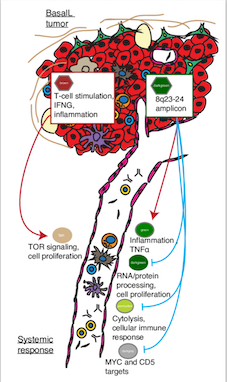The majority of cancer research to date has largely focused on understanding molecular properties of the tumor and its surrounding microenvironment in order to therapeutically target key molecular components that might drive disease progression. However, it is now well understood that cancer cells do not exist in isolation. For example, we presented quantitative evidence that the tumor and microenvironment for many breast cancer patients (~20%) do not provide sufficient information to predict how the disease will progress. There does not appear to be any signals at the tumor site that alone are good markers of response to standard of care treatment and ultimately patient prognosis. In turn, this suggests that other factors external to the tumor including, for example, the patient’s immune system, gut microbiome, lifestyle and exposures may play a significant role in disease progression.
In our most recent study, we established the existence of several molecular interactions between the primary tumor and the patient systemic response. That is, we identified molecular processes and pathways in the primary breast tumor that are tightly co-expressed with molecular processes and pathways in the patient blood cells (our surrogate to measure the patient systemic response).

The gut microbiome has been implicated in a vast number of host’s physiological processes. Analogous to our studies of the immune system, we have also initiated studies to characterize these complex microbial communities, and explore how it is affected by one's lifestyle and how it might benefit the host by impacting functions in another tissue (eg systemic immune response to cancer).
These interactions and additional information regarding patient exposure and life-style information are the first steps towards a new generation of integrative holistic predictors for a broad range of clinical end-points: diagnostics, response to therapies, prognosis and disease monitoring.
Relevant recent papers:
Interactions between the tumor and the blood systemic response of breast cancer patients
The prognostic ease and difficulty of invasive breast carcinoma
Relevant recent software packages:
MIxT: system designed for exploring and comparing transcriptional profiles from two or more matched tissues across individuals.
Relevant websites:
Tumor-blood interactions in breast cancer patients
Tumor epithelium-stroma interactions in breast cancer